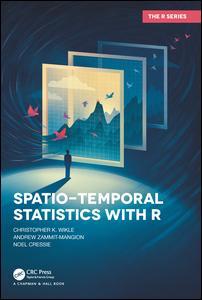Description
Spatio-Temporal Statistics with R
Chapman & Hall/CRC The R Series
Authors: Wikle Christopher K., Zammit-Mangion Andrew, Cressie Noel
Language: English
Subject for Spatio-Temporal Statistics with R:
Keywords
Data Set; spatial; Prediction Standard Errors; hierarchical modeling; Spatio Temporal Data; visualization; Spatio Temporal Covariance Function; geostatistics; Central USA; dynamic models; Empirical Orthogonal Functions; point processes; Spatio Temporal Prediction; Empirical Semivariogram; Package INLA; DSTM; Spatio Temporal Data Set; Data Frame; Spatio Temporal Modeling; Spatio Temporal Dependence; SST Data Set; PC Time Series; SST Data; NOAA Earth System Research Laboratory; CRPS; SST Anomaly; Roc Curve; Temporal Basis Functions; Predictive Distribution; Proper Scoring Rules; Rank Histogram
62.49 €
In Print (Delivery period: 14 days).
Add to cart· 17.8x25.4 cm · Hardback
Description
/li>Contents
/li>Readership
/li>Biography
/li>
The world is becoming increasingly complex, with larger quantities of data available to be analyzed. It so happens that much of these "big data" that are available are spatio-temporal in nature, meaning that they can be indexed by their spatial locations and time stamps.
Spatio-Temporal Statistics with R provides an accessible introduction to statistical analysis of spatio-temporal data, with hands-on applications of the statistical methods using R Labs found at the end of each chapter. The book:
- Gives a step-by-step approach to analyzing spatio-temporal data, starting with visualization, then statistical modelling, with an emphasis on hierarchical statistical models and basis function expansions, and finishing with model evaluation
- Provides a gradual entry to the methodological aspects of spatio-temporal statistics
- Provides broad coverage of using R as well as "R Tips" throughout.
- Features detailed examples and applications in end-of-chapter Labs
- Features "Technical Notes" throughout to provide additional technical detail where relevant
- Supplemented by a website featuring the associated R package, data, reviews, errata, a discussion forum, and more
The book fills a void in the literature and available software, providing a bridge for students and researchers alike who wish to learn the basics of spatio-temporal statistics. It is written in an informal style and functions as a down-to-earth introduction to the subject. Any reader familiar with calculus-based probability and statistics, and who is comfortable with basic matrix-algebra representations of statistical models, would find this book easy to follow. The goal is to give as many people as possible the tools and confidence to analyze spatio-temporal data.
1. Introduction to Spatio-Temporal Statistics. 2. Exploring Spatio-Temporal Data. 3. Spatio-Temporal Statistical Models. 4. Descriptive Spatio-Temporal Statistical Models. 5. Dynamic Spatio-Temporal Models. 6. Evaluating Spatio-Temporal Statistical Models. Pergimus (Epilogue). Appendices.
CHRISTOPHER K. WIKLE is Curators’ Distinguished Professor and Chair of the Department of Statistics at the University of Missouri, USA.
ANDREW ZAMMIT-MANGION is a Discovery Early Career Researcher Award (DECRA) Fellow and Senior Lecturer in the School of Mathematics and Applied Statistics at the University of Wollongong, Australia.
NOEL CRESSIE, FAA is Distinguished Professor in the School of Mathematics and Applied Statistics and Director of the Centre for Environmental Informatics at the University of Wollongong, Australia.




